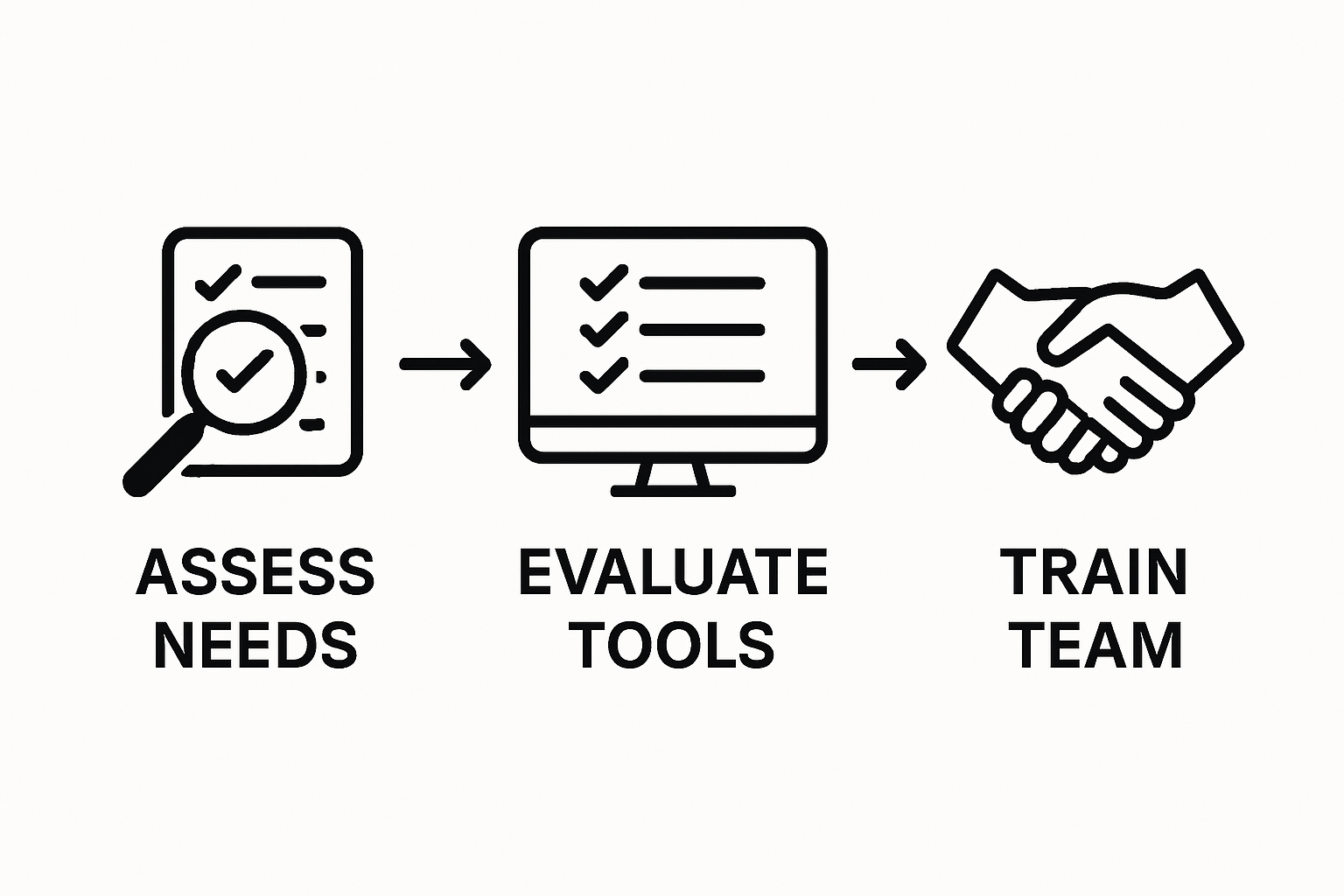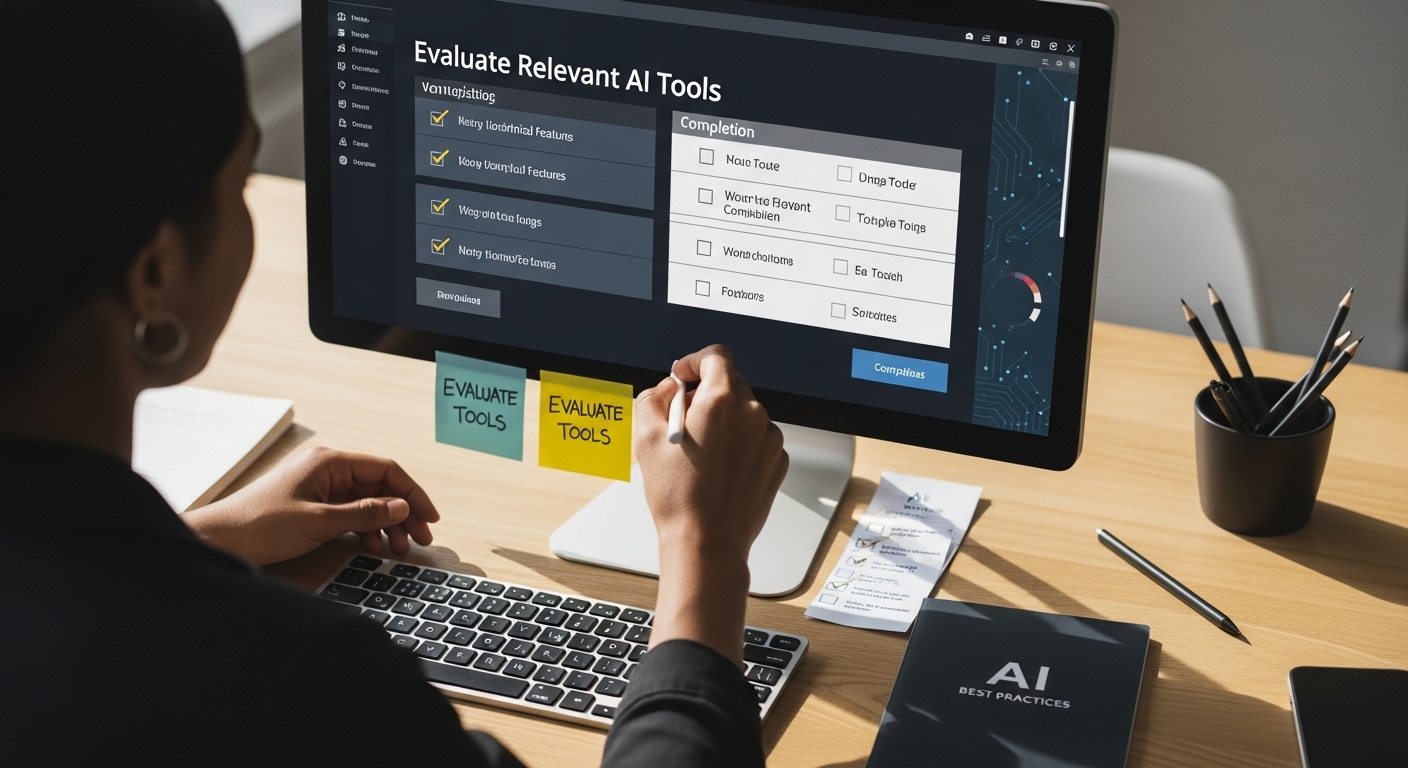How to Implement AI Safely in Your Business Operations

AI is changing the way small businesses work every single day. Some owners are seeing teams save up to dozens of hours each month just by automating routine tasks. Most people expect this is all about robots taking over jobs or making things complicated, but that’s not what creates real wins. The surprising truth is the best results happen when humans and AI team up, not when one tries to replace the other.
Table of Contents
- Step 1: Assess Your Business Needs For AI Integration
- Step 2: Identify And Evaluate Relevant AI Tools
- Step 3: Develop A Responsible AI Implementation Plan
- Step 4: Train Your Team On AI Best Practices
- Step 5: Monitor And Evaluate AI Performance Continuously
Quick Summary
| Key Point | Explanation |
|---|---|
| 1. Assess Business Needs First | Conduct an internal audit to identify inefficiencies and repetitive tasks suitable for AI integration. |
| 2. Evaluate AI Tools Carefully | Create a matrix of challenges and research AI solutions that align with your business processes for the best fit. |
| 3. Develop a Responsible Implementation Plan | Establish guidelines prioritizing human oversight, ethical usage, and data management in AI applications. |
| 4. Train your Team Effectively | Design a training program that emphasizes practical AI applications, ethical considerations, and hands-on experience. |
| 5. Continuous Monitoring is Essential | Set up regular performance evaluations and feedback mechanisms that align AI tools with evolving business needs. |
Step 1: Assess Your Business Needs for AI Integration
Implementing AI safely begins with a strategic and thoughtful assessment of your specific business requirements. This crucial first step determines whether AI can genuinely enhance your operations or if it would simply add unnecessary complexity. Business owners must approach AI integration not as a trendy solution but as a targeted strategy designed to solve real operational challenges.
Start by conducting a comprehensive internal audit of your current business processes. Walk through each department and identify repetitive tasks, bottlenecks, and areas where human productivity could be significantly improved through intelligent automation. Look for processes that consume substantial time but offer minimal strategic value. These might include data entry, scheduling, customer service triage, or reporting tasks that require significant manual effort.
Your assessment should focus on measurable outcomes. Quantify the potential time and cost savings by tracking current process inefficiencies. For instance, calculate how many hours your team spends on manual data reconciliation or customer support ticket management. These metrics will help you determine whether AI implementation provides meaningful business value. Read more about owner-led AI adoption strategies to refine your approach.
Critical evaluation criteria for potential AI integration include:
- Scalability of the proposed AI solution
- Compatibility with existing technological infrastructure
- Potential return on investment
- Complexity of implementation
- Training requirements for your team
Remember that successful AI integration is not about replacing humans but empowering them. Your team’s domain expertise remains the most crucial component in steering AI initiatives. Engage your employees throughout this assessment process, gathering insights about pain points and potential improvement areas. Their frontline experience will provide invaluable perspectives on where AI can make the most significant impact.
By the end of this assessment, you should have a clear, documented understanding of which business processes are prime candidates for AI enhancement. This roadmap will serve as your strategic guide, ensuring that AI implementation is purposeful, measured, and aligned with your broader business objectives.

Step 2: Identify and Evaluate Relevant AI Tools
After thoroughly assessing your business needs, the next critical step is identifying and carefully evaluating AI tools that align precisely with your operational requirements. This process demands a strategic approach that goes beyond surface-level features and delves into how each potential solution can genuinely transform your business workflows.
Begin by creating a comprehensive matrix of your specific operational challenges. Technology selection is not about adopting the most sophisticated tool, but finding the right fit for your unique business ecosystem. Research AI solutions that directly address the inefficiencies you identified during your initial assessment. Look for tools that offer seamless integration with your existing technological infrastructure, provide clear scalability options, and demonstrate a proven track record in your industry.
Your evaluation should encompass multiple critical dimensions. Consider not just the technical capabilities of the AI tool, but also its user experience, implementation complexity, and long-term support model. Engage with potential vendors through detailed demonstrations and trial periods. Request case studies from businesses similar to yours that have successfully implemented these tools. Explore our strategic challenges evaluation guide to refine your selection process.
Key evaluation criteria for AI tools include:
- Compatibility with existing software systems
- Data security and privacy protections
- Customization capabilities
- Transparent pricing structure
- Quality of customer support
- Ease of employee training
Crucial to this process is maintaining a human-centric perspective. The most advanced AI tool becomes ineffective if your team cannot comfortably integrate it into their daily workflows. Involve key team members in product demonstrations and gather their feedback. Their practical insights will reveal potential adoption challenges that might not be immediately apparent during initial evaluations.
Below is a summary table of key evaluation criteria when assessing AI tools, helping you compare options efficiently and prioritize your selection process.
| Evaluation Criteria | What to Look For | Why It Matters |
|---|---|---|
| Compatibility | Integrates with current software and tech stack | Ensures smooth workflow and data flow |
| Data security & privacy | Protection measures for data and privacy | Protects customer and business information |
| Customization | Ability to tailor settings and features | Aligns tool with unique business needs |
| Transparent pricing | Clear, understandable costs | Avoids unexpected expenses |
| Customer support | Reliable access to help and technical guidance | Assists with troubleshooting and upgrades |
| Ease of training | User-friendly interface and resources | Reduces onboarding time for your team |
By the conclusion of this step, you should have a shortlist of 2-3 AI tools that not only meet your technical requirements but also align with your organizational culture and strategic objectives. Remember, successful AI implementation is less about technological complexity and more about creating intelligent solutions that empower your team and drive meaningful business value.

Step 3: Develop a Responsible AI Implementation Plan
A responsible AI implementation plan transforms your strategic vision into a structured, ethical roadmap that prioritizes both technological advancement and human potential. This critical step bridges the gap between AI tool selection and meaningful organizational integration, ensuring that your approach remains purposeful and aligned with your core business values.
Responsible AI implementation begins with establishing clear governance frameworks that maintain human oversight at every stage. Draft a comprehensive document that outlines precise guidelines for AI usage, defining explicit boundaries and expectations for how these tools will interact with your existing workflows. This plan should articulate not just technical specifications, but also the fundamental principles driving your AI adoption strategy. Learn how AI can future-proof your business while maintaining ethical standards.
Your implementation plan must address several interconnected dimensions. Start by creating detailed protocols for data management, emphasizing privacy protection, consent mechanisms, and transparent algorithmic decision-making processes. Consider potential bias risks and develop mitigation strategies that ensure your AI tools promote fairness and inclusivity. This means conducting thorough audits of training data and establishing regular review mechanisms to identify and correct potential discriminatory patterns.
Key components of a responsible AI implementation plan include:
- Comprehensive risk assessment framework
- Clear accountability mechanisms
- Continuous monitoring and evaluation protocols
- Employee training and change management strategies
- Ethical guidelines for AI interaction
- Mechanisms for human intervention and override
Engaging your entire team throughout this process is crucial. Schedule collaborative workshops where employees can provide input, express concerns, and understand how AI will augment rather than replace their roles. Transparency builds trust and ensures smoother technological transitions. Create channels for ongoing feedback and be prepared to adapt your implementation plan based on real-world insights and team experiences.
By the end of this step, you should have a detailed, living document that serves as a strategic blueprint for responsible AI integration. This plan will not only guide your initial implementation but also provide a flexible framework for continuous improvement and ethical technological advancement.
This checklist table outlines critical components to include in your responsible AI implementation plan, ensuring ethical, secure, and effective integration across your business operations.
| Plan Component | Description | Priority |
|---|---|---|
| Risk assessment framework | Processes for identifying and mitigating risks | High |
| Accountability mechanisms | Clear lines of responsibility and oversight | High |
| Monitoring and evaluation protocols | Regular performance and ethical reviews | High |
| Employee training and change management | Programs for preparing staff and managing adoption | Medium |
| Ethical guidelines for AI interaction | Rules to promote fair, unbiased AI use | High |
| Human intervention mechanisms | Processes to override or adjust AI decisions | High |
Step 4: Train Your Team on AI Best Practices
Successful AI implementation hinges not just on technological capabilities, but on your team’s understanding and confident engagement with these powerful tools. Training becomes the critical bridge that transforms AI from a complex technological concept into a practical, everyday business asset. The goal is not to create AI experts, but to develop practitioners who can leverage AI strategically and responsibly.
Begin by designing a comprehensive training program that demystifies AI and addresses potential team anxieties. Your approach should emphasize AI as an augmentation tool that enhances human capabilities rather than a replacement for human talent. Create interactive workshops that provide hands-on experience with the specific AI tools selected for your organization. These sessions should combine theoretical understanding with practical application, allowing team members to experiment in a controlled, supportive environment. Explore our owner-led AI adoption strategies to refine your training approach.
Your training curriculum must cover more than technical mechanics. Develop modules that explore ethical considerations, potential bias recognition, and the importance of maintaining human oversight. Encourage critical thinking about AI’s limitations and the irreplaceable value of human judgment. This approach helps team members view AI as a collaborative tool that amplifies their existing skills rather than a threatening technological replacement.
Critical training program elements include:
- Practical demonstration of AI tool functionalities
- Ethical usage guidelines
- Scenario-based learning exercises
- Clear escalation protocols for AI-related challenges
- Continuous learning and feedback mechanisms
- Psychological safety in AI interaction
Implement a phased training approach that allows for incremental learning and adaptation. Start with foundational workshops that introduce AI concepts, then progress to role-specific training that shows how AI can solve particular departmental challenges. Create mentorship opportunities where tech-savvy team members can support colleagues who might feel less comfortable with new technologies.
By the conclusion of this training phase, your team should demonstrate not just technical proficiency, but a nuanced understanding of AI’s potential and limitations. Measure success through practical assessments, confidence surveys, and observable improvements in workflow efficiency. Remember, the most sophisticated AI tool becomes powerful only when your team understands how to wield it effectively and ethically.
Step 5: Monitor and Evaluate AI Performance Continuously
Continuous monitoring and evaluation represent the critical heartbeat of responsible AI implementation. This ongoing process transforms AI from a static tool into a dynamic, adaptive system that evolves alongside your business needs. The goal is not just to track performance, but to create a responsive ecosystem where AI and human intelligence work in collaborative harmony.
Establish a robust monitoring framework that goes beyond traditional performance metrics. Create comprehensive dashboards that capture both quantitative outputs and qualitative insights. This means tracking not just efficiency gains and accuracy rates, but also examining the nuanced ways AI interactions impact team dynamics, decision-making processes, and overall organizational culture. Check out our frequently asked questions about AI strategy to understand key evaluation principles.
Develop a systematic approach to performance assessment that includes regular review intervals. Schedule monthly deep-dive evaluations where cross-functional teams analyze AI tool performance, identifying potential biases, unexpected behaviors, or emerging opportunities for optimization. These sessions should be collaborative, encouraging open dialogue about AI’s real-world application and potential refinements.
Key performance monitoring strategies include:
- Establishing baseline performance benchmarks
- Creating multi-dimensional evaluation metrics
- Implementing real-time error tracking mechanisms
- Developing transparent reporting protocols
- Building feedback loops for continuous improvement
- Maintaining human oversight at every evaluation stage
Proactive risk management becomes paramount in continuous monitoring. Develop early warning systems that can detect subtle shifts in AI performance or potential ethical breaches. This means creating clear escalation protocols where team members can quickly report unexpected AI behaviors or potential issues. Integrate machine learning models that can self-assess and flag anomalies, but always maintain human judgment as the ultimate decision-making authority.
By the conclusion of each monitoring cycle, your team should produce a comprehensive report detailing AI performance, highlighting successes, identifying improvement areas, and recommending strategic adjustments. This living document becomes your organizational roadmap for responsible AI integration, ensuring that technological advancement remains aligned with your core business values and human-centric approach.
Ready to Bridge the Gap From AI Theory to Safe Business Impact?
If you are serious about leveraging automation without creating risk or confusion, you know that safe AI adoption takes more than picking the newest tool. The article highlights the challenges business owners face: turning assessments into action, managing team worries about automation, and building a responsible AI plan that keeps people in control. Your goal is clear. You want to unlock time savings, boost team morale, and grow your business value, but you need a proven partner and a clear roadmap.

At Average Robot, we transform safe AI implementation into a simple, guided process. Our specialists work alongside your leadership team to evaluate needs, select the right automations, and build step-by-step plans that protect your culture and data. If you want to avoid overwhelm and start with practical actions, explore our owner-led AI adoption strategies. Then see how our strategic challenges evaluation guide can simplify your technology choices. Don’t let your competitors get ahead while you hesitate. Start by visiting Average Robot and schedule an expert consultation. Turn your AI vision into competitive results today.
Frequently Asked Questions
What is the first step to implement AI safely in my business?
The first step is to assess your business needs for AI integration. Conduct a comprehensive internal audit of current processes to identify tasks that could benefit from automation and ensure that AI solutions align with your operational challenges.
How do I choose the right AI tools for my business?
Start by evaluating potential AI tools that match your specific operational needs identified during your assessment. Create a matrix outlining your challenges, and consider factors such as compatibility, scalability, user experience, and customer support before making a decision.
What should a responsible AI implementation plan include?
A responsible AI implementation plan should include guidelines for governance, risk assessment frameworks, accountability mechanisms, employee training, and protocols for data management and algorithmic decision-making to ensure ethical and effective integration.
How can I ensure my team is prepared for AI implementation?
Design a comprehensive training program that emphasizes AI as an augmentation tool. Focus on practical demonstrations, ethical usage guidelines, and scenario-based learning to build confidence and understanding among team members regarding AI technologies.
Recommended
- Owner-Led AI Adoption Tips for Small Businesses — Average Robot
- Owner-Led AI Adoption Tips for Small Businesses — Average Robot
- About | Discover Opportunities - Schedule Today — Average Robot
- About | Discover Opportunities - Schedule Today — Average Robot
- The Impact of AI on SEO in 2025: Key Changes for Businesses




